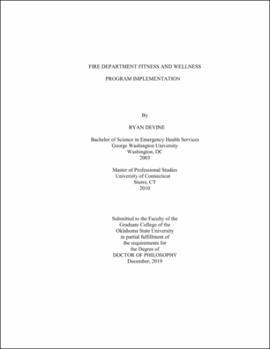| dc.contributor.advisor | Murphy, Haley | |
| dc.contributor.author | Devine, Ryan | |
| dc.date.accessioned | 2020-06-03T18:45:49Z | |
| dc.date.available | 2020-06-03T18:45:49Z | |
| dc.date.issued | 2019-12 | |
| dc.identifier.uri | https://hdl.handle.net/11244/324814 | |
| dc.description.abstract | Health promotion programs are becoming increasingly popular throughout the private sector. The return on investment averages between $3 - $6 for every dollar spent on program costs. Despite this, implementation has lagged among career fire departments. This study examines the barriers that exist in implementing fire department fitness and wellness programs. This quantitative research project utilizes a survey conducted on a major, career department located in the Northeastern US. The goal of the survey is to better understand/predict firefighter motivations and willingness in order to promote fitness and wellness programs. The survey focuses on barriers towards cooperation and how impacts of demographics (age groups/time on job/current health perception) affects responses. Finally, the survey concludes with a list of incentives that increase in value/cost in order to determine willingness of accepting a program if it were voluntary, non-punitive, with age-based fitness goals. Variables include three main groups; older and younger firefighters, those with more/less years on the job and those with higher and lower fitness levels. The survey examines fitness motivation in fourteen distinct categories and an exercise causality index (determining how individuals are orientated to exercise). The survey concludes with incentives and program offerings to determine preferences by department, by groups or individuals. This research determined that younger firefighters and those with fewer years on the job are more willing to accept health promotion programs than older members. Motivation levels decrease in nearly every category for older members. Those with lower fitness scores are also less willing to accept a comprehensive program. Despite this, nearly all ages and demographics understand the importance of firefighters maintaining a high level of fitness and wellness. This survey has proved to be helpful in understanding the demographics of a particular department, understanding likes/dislikes, strengths and weaknesses in order to design and implement a program that has the best chance of being accepted by the majority and that has the best chance of lasting long term. | |
| dc.format | application/pdf | |
| dc.language | en_US | |
| dc.rights | Copyright is held by the author who has granted the Oklahoma State University Library the non-exclusive right to share this material in its institutional repository. Contact Digital Library Services at lib-dls@okstate.edu or 405-744-9161 for the permission policy on the use, reproduction or distribution of this material. | |
| dc.title | Fire department fitness and wellness program implementation | |
| dc.contributor.committeeMember | Wu, Tristan | |
| dc.contributor.committeeMember | Chang, Ray | |
| dc.contributor.committeeMember | Mendez, Jeanette | |
| osu.filename | Devine_okstate_0664D_16532.pdf | |
| osu.accesstype | Open Access | |
| dc.type.genre | Dissertation | |
| dc.type.material | Text | |
| dc.subject.keywords | department | |
| dc.subject.keywords | fire | |
| dc.subject.keywords | fitness | |
| dc.subject.keywords | health | |
| dc.subject.keywords | program | |
| dc.subject.keywords | wellness | |
| thesis.degree.discipline | Fire and Emergency Management Administration | |
| thesis.degree.grantor | Oklahoma State University | |
